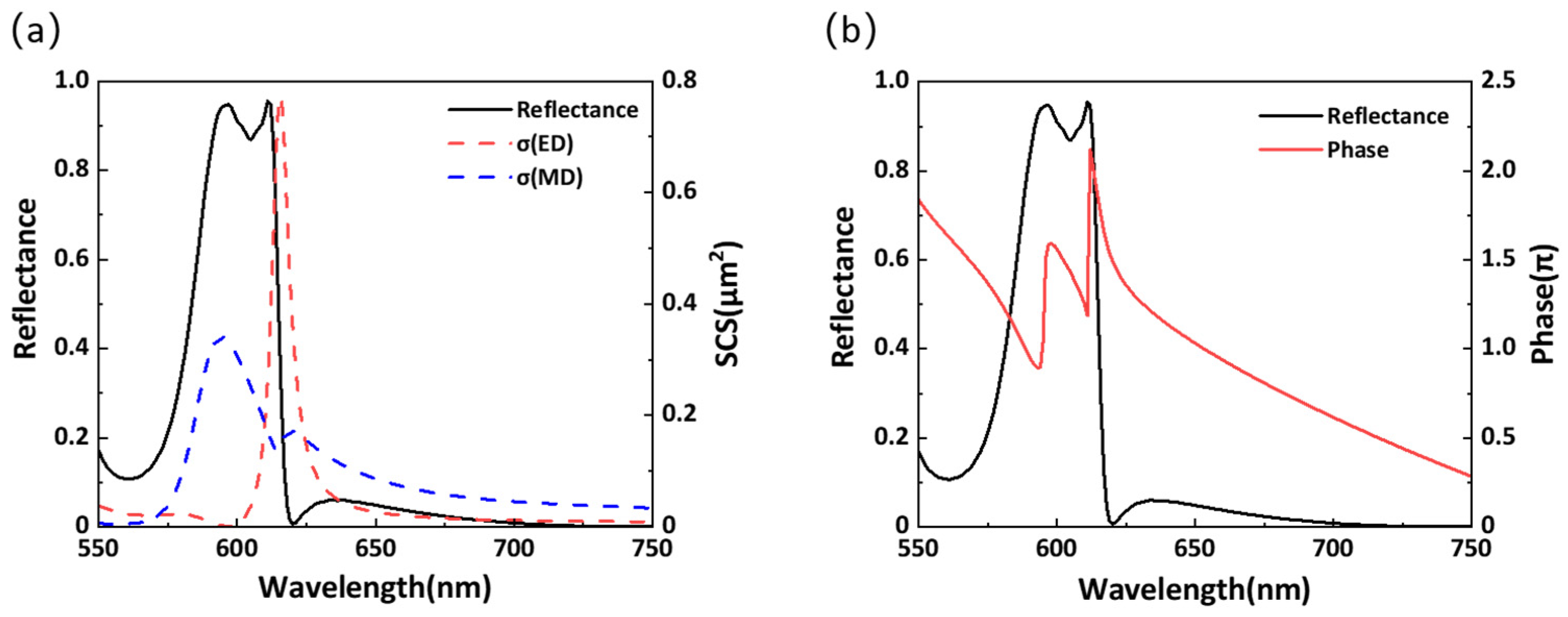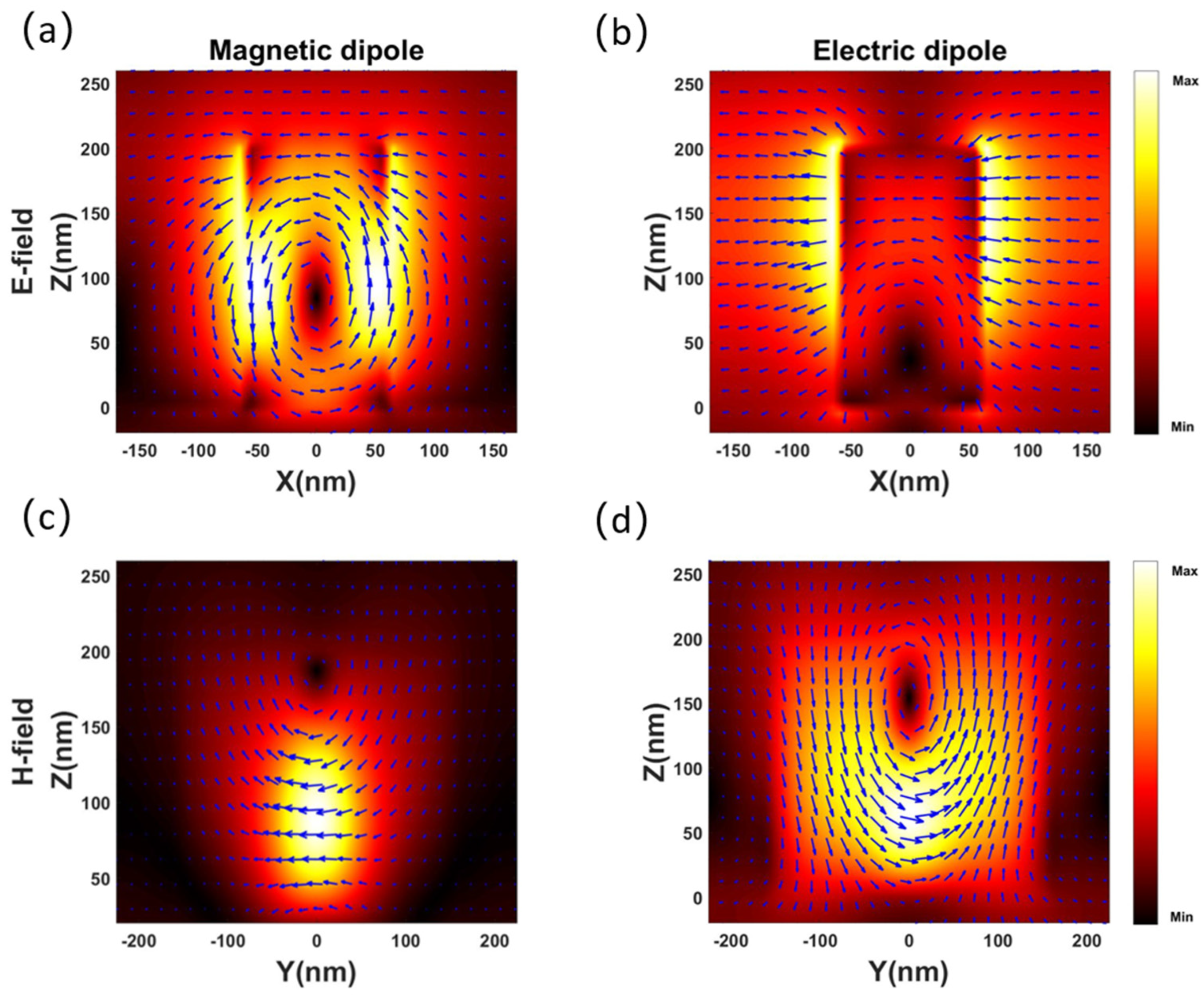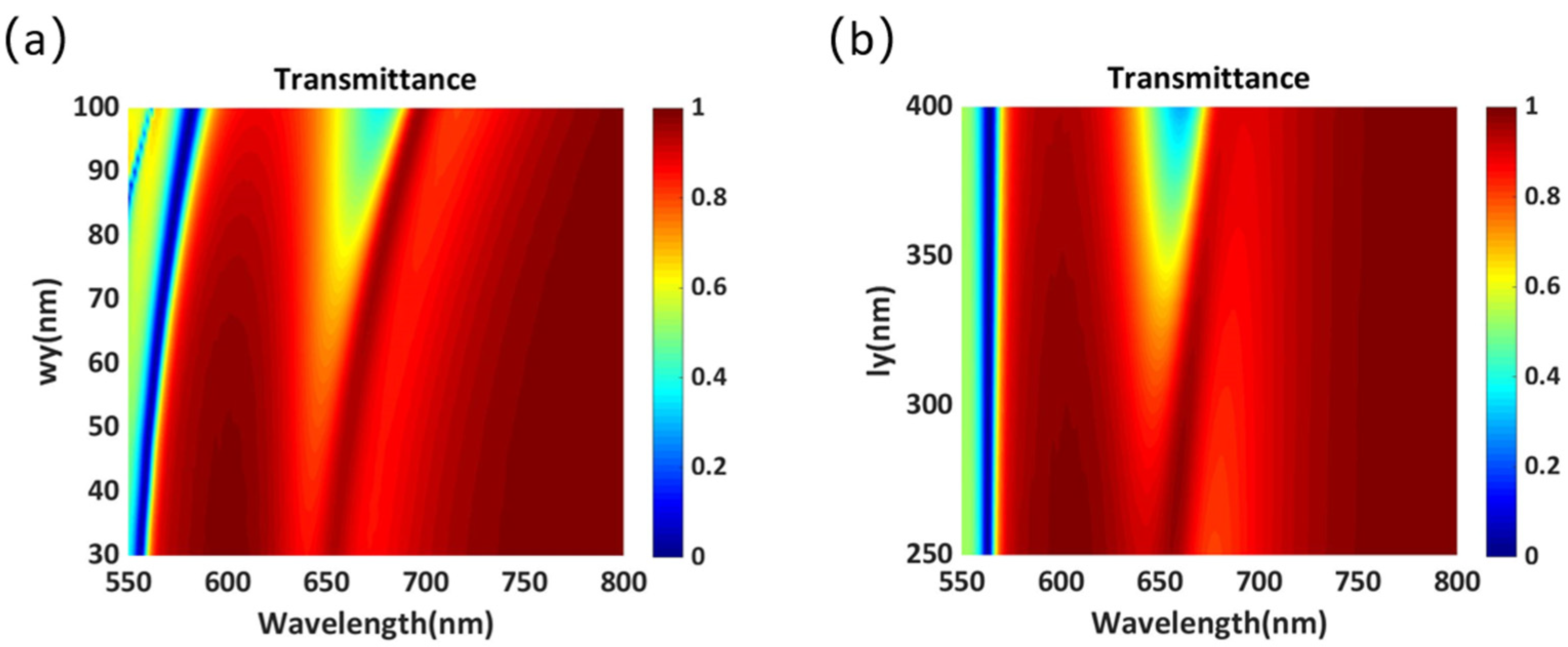All-Dielectric Huygens’ Metasurface for Wavefront Manipulation in the Visible Region
Abstract
:1. Introduction
2. Design Strategy
2.1. Electromagnetic Multipole Decomposition Method
2.2. Metasurface Design
3. Results and Discussion
4. Conclusions
Author Contributions
Funding
Institutional Review Board Statement
Informed Consent Statement
Data Availability Statement
Acknowledgments
Conflicts of Interest
References
- Yu, N.; Genevet, P.; Kats, M.A.; Aieta, F.; Tetienne, J.P.; Capasso, F.; Gaburro, Z. Light propagation with phase discontinuities: Generalized laws of reflection and refraction. Science 2011, 334, 333–337. [Google Scholar] [CrossRef] [PubMed] [Green Version]
- Chalabi, H.; Ra’di, Y.; Sounas, D.L.; Alu, A. Efficient anomalous reflection through near-field interactions in metasurfaces. Phys. Rev. B 2017, 96, 075432. [Google Scholar] [CrossRef] [Green Version]
- Liu, W.; Miroshnichenko, A.E. Beam Steering with Dielectric Metalattices. ACS Photon. 2018, 5, 1733–1741. [Google Scholar] [CrossRef]
- Wu, A.; Li, H.; Du, J.; Ni, X.; Ye, Z.; Wang, Y.; Sheng, Z.; Zou, S.; Gan, F.; Zhang, X.; et al. Experimental Demonstration of In-Plane Negative-Angle Refraction with an Array of Silicon Nanoposts. Nano Lett. 2015, 15, 2055–2060. [Google Scholar] [CrossRef]
- Fathnan, A.A.; Liu, M.K.; Powell, D.A. Achromatic Huygens’ Metalenses with Deeply Subwavelength Thickness. Adv. Opt. Mater. 2020, 8, 2000754. [Google Scholar] [CrossRef]
- Wang, B.; Dong, F.L.; Li, Q.T.; Yang, D.; Sun, C.W.; Chen, J.J.; Song, Z.W.; Xu, L.H.; Chu, W.G.; Xiao, Y.F.; et al. Visible-Frequency Dielectric Metasurfaces for Multiwavelength Achromatic and Highly Dispersive Holograms. Nano Lett. 2016, 16, 5235–5240. [Google Scholar] [CrossRef]
- Arbabi, E.; Kamali, S.M.; Arbabi, A.A.; Faraon, A. Vectorial Holograms with a Dielectric Metasurface: Ultimate Polarization Pattern Generation. ACS Photon. 2019, 6, 2712–2718. [Google Scholar] [CrossRef] [Green Version]
- Sun, J.B.; Wang, X.; Xu, T.; Kudyshev, Z.A.; Cartwright, A.N.; Litchinitser, N.M. Spinning Light on the Nanoscale. Nano Lett. 2014, 14, 2726–2729. [Google Scholar] [CrossRef]
- Bao, Y.J.; Ni, J.C.; Qiu, C.W. A Minimalist Single-Layer Metasurface for Arbitrary and Full Control of Vector Vortex Beams. Adv. Mater. 2020, 32, 1905659. [Google Scholar] [CrossRef]
- Amir, A.; Yu, H.; Mahmood, B.; Andrei, F. A dielectric metasurfaces for complete control of phase and polarization with subwavelength spatial resolution and high transmission. Nat. Nanotechnol. 2015, 10, 937–944. [Google Scholar]
- Shalaev, M.I.; Sun, J.B.; Tsukernik, A.; Pandey, A.; Nikolskiy, K.; Litchinister, N.M. High-Efficiency All-Dielectric Metasurfaces for Ultracompact Beam Manipulation in Transmission Mode. Nano Lett. 2015, 15, 6261–6266. [Google Scholar] [CrossRef] [Green Version]
- Zhou, Z.P.; Li, J.T.; Su, R.B.; Yao, B.M.; Fang, H.L.; Li, K.Z.; Zhou, L.D.; Liu, J.; Stellinga, D.; Reardon, C.P.; et al. Efficient Silicon Metasurfaces for Visible Light. ACS Photon. 2017, 4, 544–551. [Google Scholar] [CrossRef]
- Li, J.; Wu, T.S.; Xu, W.B.; Liu, Y.M.; Liu, C.; Wang, Y.; Yu, Z.Y.; Zhu, D.F.; Yu, L.; Ye, H. Mechanisms of 2π phase control in dielectric metasurface and transmission enhancement effect. Opt. Express 2019, 27, 23186–23196. [Google Scholar] [CrossRef] [PubMed]
- Yang, L.; Wu, D.; Liu, Y.M.; Liu, C.; Xu, Z.H.; Li, H.; Yu, Z.Y.; Yu, L.; Ye, H. High-efficiency all-dielectric transmission metasurface for linearly polarized light in the visible region. Photonics Res. 2018, 6, 517–524. [Google Scholar] [CrossRef]
- Li, B.H.; Li, X.W.; Zhao, R.Z.; Wang, G.C.; Han, W.N.; Zhao, B.Q.; Huang, L.L.; Zhang, Y.; Lu, Y.F.; Jiang, L. Polarization Multiplexing Terahertz Metasurfaces through Spatial Femtosecond Laser-Shaping Fabrication. Adv. Opt. Mater. 2020, 8, 2000136. [Google Scholar] [CrossRef]
- Yu, C.Y.; Zeng, Q.C.; Yu, C.J.; Han, C.Y.; Wang, C.M. Scattering Analysis and Efficiency Optimization of Dielectric Pancharatnam-Berry-Phase Metasurfaces. Nanomaterials 2021, 11, 586. [Google Scholar] [CrossRef] [PubMed]
- Jiang, Q.; Cao, L.C.; Huang, L.L.; He, Z.H.; Jin, G.F. A complex-amplitude hologram using an ultra-thin dielectric metasurface. Nanoscale 2020, 12, 24162–24168. [Google Scholar] [CrossRef]
- Ollanik, A.J.; Smith, J.A.; Belue, M.J.; Escarra, M.D. High-Efficiency All-Dielectric Huygens Metasurfaces from the Ultraviolet to the Infrared. ACS Photon. 2018, 5, 1351–1358. [Google Scholar] [CrossRef]
- Babicheva, V.E.; Evlyukhin, A.B. Resonant Lattice Kerker Effect in Metasurfaces with Electric and Magnetic Optical Responses. Laser Photon. Rev. 2017, 11, 1700132. [Google Scholar] [CrossRef] [Green Version]
- Zhao, R.; Zhu, Z.; Dong, G.; Lv, T.; Li, Y.; Guan, C.; Shi, J.; Zhang, H. High-efficiency Huygens’ metasurface for terahertz wave manipulation. Opt. Lett. 2019, 44, 3482–3485. [Google Scholar] [CrossRef]
- Kim, M.; Wong, A.M.H.; Eleftheriades, G.V. Optical Huygens’ Metasurfaces with Independent Control of the Magnitude and Phase of the Local Reflection Coefficients. Phys. Rev. X 2014, 4, 041042. [Google Scholar] [CrossRef]
- Liu, S.; Vaskin, A.; Campione, S.; Wolf, O.; Sinclair, M.B.; Reno, J.; Keeler, G.A.; Staude, I.; Brener, I. Huygens’ Metasurfaces Enabled by Magnetic Dipole Resonance Tuning in Split Dielectric Nanoresonators. Nano Lett. 2017, 17, 4297–4303. [Google Scholar] [CrossRef] [PubMed]
- Yu, Y.F.; Zhu, A.Y.; Paniagua-Dominguez, R.; Fu, Y.H.; Luk’yanchuk, B.; Kuznetsov, A.I. High-transmission dielectric metasurface with 2π phase control at visible wavelengths. Laser Photon. Rev. 2015, 9, 412–418. [Google Scholar] [CrossRef]
- Staude, I.; Miroshnichenko, A.E.; Decker, M.; Fofang, N.T.; Liu, S.; Gonzales, E.; Domingguez, J.; Luk, T.S.; Neshev, D.N.; Brener, I.; et al. Tailoring directional scattering through magnetic and electric resonances in subwavelength silicon nanodisks. ACS Nano 2013, 7, 7824–7832. [Google Scholar] [CrossRef]
- Eismann, J.S.; Neugebauer, M.; Banzer, P. Exciting a chiral dipole moment in an achiral nanostructure. Optica 2018, 5, 954–959. [Google Scholar] [CrossRef]
- Zhao, W.; Jiang, H.; Liu, B.; Song, J.; Jiang, Y. High-efficiency beam manipulation combining geometric phase with anisotropic Huygens surface. Appl. Phys. Lett. 2016, 108, 181102. [Google Scholar] [CrossRef]
- Liu, C.; Ye, H.; Wang, Y.; Sun, Y.; Liu, Y.; Yu, Z.; Yu, L. Beyond dipole excitation: The performance of quadrupole-based Huygens’ metasurface. Opt. Lett. 2020, 45, 4847–4850. [Google Scholar] [CrossRef]
- Liu, C.; Chen, L.; Wu, T.; Liu, Y.; Li, J.; Wang, Y.; Yu, Z.; Ye, H.; Yu, L. All-dielectric three-element transmissive Huygens’ metasurface performing anomalous refraction. Photon. Res. 2019, 7, 1501–1510. [Google Scholar] [CrossRef]
- Petschulat, J.; Menzel, C.; Chipoiline, A.; Rockstuhl, C.; Tunnermann, A.; Lederer, F.; Pertsch, T. Multipole approach to metamaterials. Phys. Rev. A 2008, 78, 043811. [Google Scholar] [CrossRef]
- Evlyukhin, A.B.; Reinhardt, C.; Chichkov, B.N. Multipole light scattering by nonspherical nanoparticles in the discrete dipole approximation. Phys. Rev. B 2011, 84, 235429. [Google Scholar] [CrossRef]
- Zhang, X.; Li, J.; Donegan, J.F.; Bradley, A.L. Constructive and destructive interference of Kerker-type scattering in an ultrathin silicon Huygens metasurface. Phys. Rev. Mater. 2020, 4, 125202. [Google Scholar] [CrossRef]
- Molet, P.; Gil-Herrera, L.K.; Garcia-Pomar, J.L.; Caselli, N.; Blanco, A.; Lopez, C.; Mihi, A. Large area metasurfaces made with spherical silicon resonators. Nanophotonics 2020, 9, 943–951. [Google Scholar] [CrossRef]
- Evlyukhin, A.B.; Reinhardt, C.; Evlyukhin, E.; Chichkov, B.N. Multipole analysis of light scattering by arbitrary-shaped nanoparticles on a plane surface. J. Opt. Soc. Am. B 2013, 30, 2589–2598. [Google Scholar] [CrossRef]
- Evlyukhin, A.B.; Fischer, T.; Reinhardt, C.; Chichkov, B.N. Optical theorem and multipole scattering of light by arbitrarily shaped nanoparticles. Phys. Rev. B 2016, 94, 205434. [Google Scholar] [CrossRef]
- COMSOL Multiphysics® v. 5.5. COMSOL AB: Stockholm, Sweden. Available online: cn.comsol.com (accessed on 8 October 2021).
- Zollner, S.; Lin, C.; Schönherr, E.; Böhringer, A.; Cardona, M. The dielectric function of AlSb from 1.4 to 5.8 eV determined by spectroscopic ellipsometry. J. Appl. Phys. 1989, 66, 383–387. [Google Scholar] [CrossRef]
- Solutions, F.D.T.D. Lumerical’s Nanophotonic FDTD Simulation Software. Available online: https://www.lumerical.com/tcad-products/fdtd/ (accessed on 8 October 2021).












| Element | lx (nm) | wx (nm) | ly (nm) | wy (nm) | wx’ (nm) | wy’ (nm) |
|---|---|---|---|---|---|---|
| E1 | 197 | 67 | 385 | 94 | 36 | 46 |
| E2 | 301 | 79 | 344 | 60 | 35 | 30 |
Publisher’s Note: MDPI stays neutral with regard to jurisdictional claims in published maps and institutional affiliations. |
© 2021 by the authors. Licensee MDPI, Basel, Switzerland. This article is an open access article distributed under the terms and conditions of the Creative Commons Attribution (CC BY) license (https://creativecommons.org/licenses/by/4.0/).
Share and Cite
Wu, T.; Liu, Z.; Cao, W.; Zhang, H.; Yang, D.; Yang, Z. All-Dielectric Huygens’ Metasurface for Wavefront Manipulation in the Visible Region. Materials 2021, 14, 5967. https://doi.org/10.3390/ma14205967
Wu T, Liu Z, Cao W, Zhang H, Yang D, Yang Z. All-Dielectric Huygens’ Metasurface for Wavefront Manipulation in the Visible Region. Materials. 2021; 14(20):5967. https://doi.org/10.3390/ma14205967
Chicago/Turabian StyleWu, Tiesheng, Zhihui Liu, Weiping Cao, Huixian Zhang, Dan Yang, and Zuning Yang. 2021. "All-Dielectric Huygens’ Metasurface for Wavefront Manipulation in the Visible Region" Materials 14, no. 20: 5967. https://doi.org/10.3390/ma14205967
APA StyleWu, T., Liu, Z., Cao, W., Zhang, H., Yang, D., & Yang, Z. (2021). All-Dielectric Huygens’ Metasurface for Wavefront Manipulation in the Visible Region. Materials, 14(20), 5967. https://doi.org/10.3390/ma14205967






